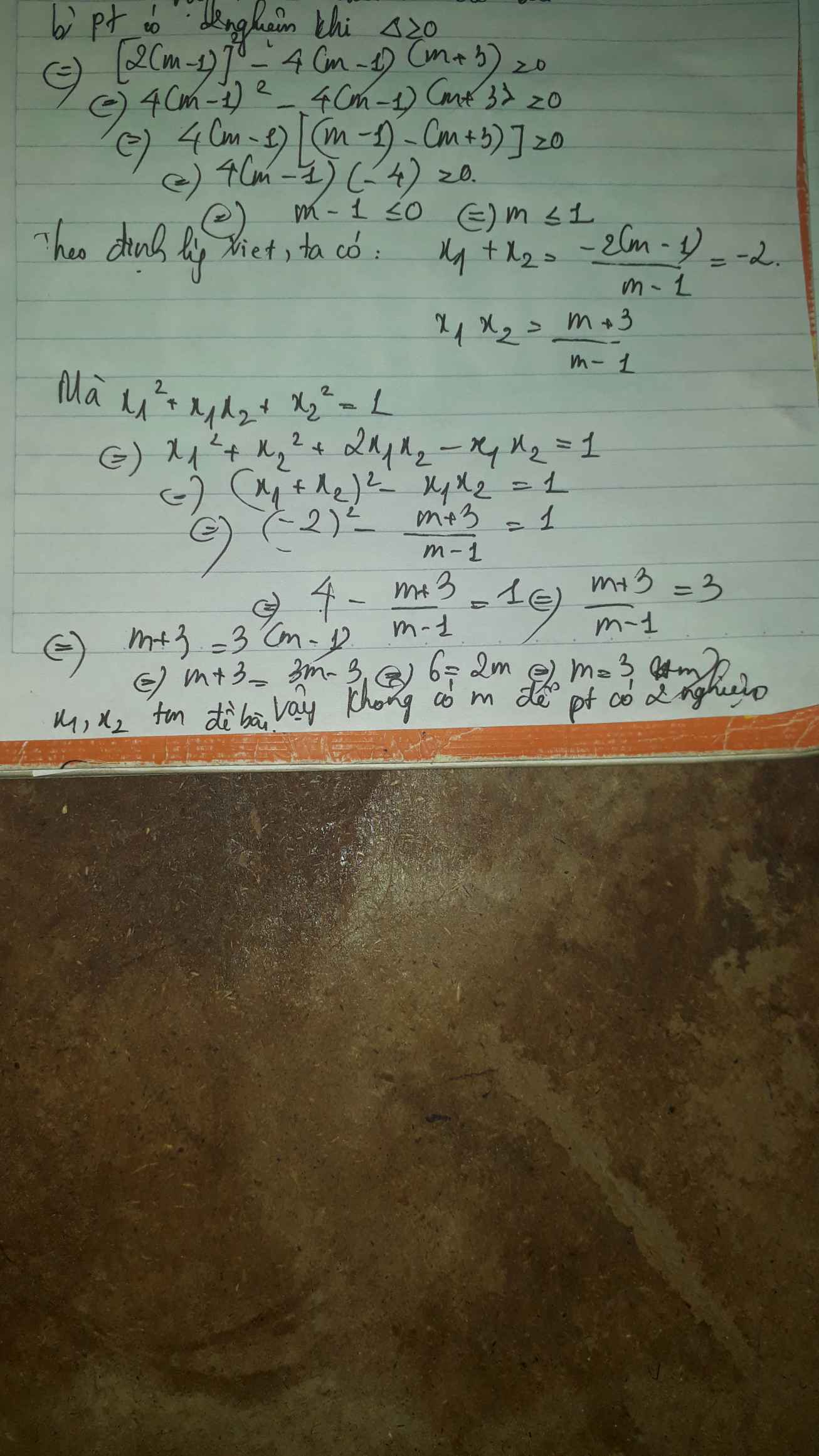Hãy nhập câu hỏi của bạn vào đây, nếu là tài khoản VIP, bạn sẽ được ưu tiên trả lời.

Ta có: \(\Delta=4m^2+4m-11\)
Để phương trình có 2 nghiệm phân biệt \(\Leftrightarrow4m^2+4m-11>0\)
Theo Vi-ét, ta có: \(\left\{{}\begin{matrix}x_1+x_2=2m+3\\x_1x_2=2m+5\end{matrix}\right.\)
Để phương trình có 2 nghiệm dương phân biệt
\(\Leftrightarrow\left\{{}\begin{matrix}4m^2+4m-11>0\\2m+3>0\\2m+5>0\end{matrix}\right.\) \(\Leftrightarrow\left\{{}\begin{matrix}\left[{}\begin{matrix}m< \dfrac{-1-2\sqrt{3}}{2}\\m>\dfrac{-1+2\sqrt{3}}{2}\end{matrix}\right.\\m>-\dfrac{3}{2}\\m>-\dfrac{5}{2}\end{matrix}\right.\) \(\Leftrightarrow m>\dfrac{-1+2\sqrt{3}}{2}\)
Mặt khác: \(\dfrac{1}{\sqrt{x_1}}+\dfrac{1}{\sqrt{x_2}}=\dfrac{4}{3}\)
\(\Rightarrow\dfrac{x_1+x_2+2\sqrt{x_1x_2}}{x_1x_2}=\dfrac{16}{9}\) \(\Rightarrow\dfrac{2m+3+2\sqrt{2m+5}}{2m+5}=\dfrac{16}{9}\)
\(\Rightarrow18m+27+18\sqrt{2m+5}=32m+80\)
\(\Leftrightarrow14m-53=18\sqrt{2m+5}\)
\(\Rightarrow\) ...

\(x^2-\left(m+1\right)x+m+4=0\left(1\right)\)
\(\Rightarrow\Delta>0\Leftrightarrow\left(m+1\right)^2-4\left(m+4\right)>0\Leftrightarrow\left[{}\begin{matrix}m< -3\\m>5\end{matrix}\right.\)\(\left(2\right)\)
\(ddkt-thỏa:\sqrt{x1}+\sqrt{x2}=2\sqrt{3}\)
\(x1=0\Rightarrow\left(1\right)\Leftrightarrow m=-4\Rightarrow\left(1\right)\Leftrightarrow x^2+3x=0\Leftrightarrow\left[{}\begin{matrix}x1=0\\x2=-3< 0\left(loại\right)\end{matrix}\right.\)
\(x1\ne0\) \(\Rightarrow0< x1< x2\)
\(\Leftrightarrow\left\{{}\begin{matrix}x1+x2>0\\x1x2>0\end{matrix}\right.\Leftrightarrow\left\{{}\begin{matrix}m+1>0\\m+4>0\end{matrix}\right.\)\(\Rightarrow m>-1\)\(\left(3\right)\)
\(\left(2\right)\left(3\right)\Rightarrow m>5\)
\(\Rightarrow\sqrt{x1}+\sqrt{x2}=2\sqrt{3}\)
\(\Leftrightarrow x1+x2+2\sqrt{x1x2}=12\Leftrightarrow m+1+2\sqrt{m+4}=12\)
\(\Leftrightarrow m+4+2\sqrt{m+4}-15=0\)
\(đặt:\sqrt{m+4}=t>5\Rightarrow t^2+2t-15=0\Leftrightarrow\left[{}\begin{matrix}t=-5\left(ktm\right)\\t=3\left(ktm\right)\end{matrix}\right.\)
\(\Rightarrow m\in\phi\)
Để pt có 2 nghiệm pb
\(\left(m+1\right)^2-4\left(m+4\right)=m^2+2m+1-4m-16\)
\(=m^2-2m-15>0\)
Theo Vi et \(\left\{{}\begin{matrix}x_1+x_2=m+1\\x_1x_2=m+4\end{matrix}\right.\)
Ta có : \(\left(\sqrt{x_1}+\sqrt{x_2}\right)^2=12\Leftrightarrow x_1+2\sqrt{x_1x_2}+x_2=12\)
Thay vào ta được \(m+1+2\sqrt{m+4}=12\Leftrightarrow2\sqrt{m+4}=11-m\)đk : m >= -4
\(\Leftrightarrow4\left(m+4\right)=121-22m+m^2\Leftrightarrow m^2-26m+105=0\)
\(\Leftrightarrow m=21\left(ktm\right);m=5\left(ktm\right)\)

a, Thay \(m=-3\) vào \(\left(1\right)\)
\(x^2-2.\left(m-1\right)x-m-3=0\\ \Leftrightarrow x^2-2.\left(-3-1\right)x+3-3=0\\ \Leftrightarrow x^2+8x=0\\ \Leftrightarrow x\left(x+8\right)=0\\ \Leftrightarrow\left[{}\begin{matrix}x=0\\x=-8\end{matrix}\right.\)
Vậy với \(m=-3\) thì \(x=0;x=-8\)
b,
\(\Delta'=\left[-\left(m-1\right)\right]^2-1.\left(-m-3\right)\\ =m^2-2m+1+m+3\\ =m^2-m+4\)
phương trình có hai nghiệm phân biệt
\(\Delta'>0\\ m^2-m+4>0\\ \Rightarrow m^2-2.\dfrac{1}{2}m+\dfrac{1}{4}+\dfrac{7}{2}>0\\ \Leftrightarrow\left(m-\dfrac{1}{2}\right)^2+\dfrac{7}{2}>0\left(lđ\right)\)
\(\Rightarrow\forall m\)
Áp dụng hệ thức Vi ét :
\(\left\{{}\begin{matrix}x_1+x_2=2\left(m-1\right)\\x_1x_2=-m-3\end{matrix}\right.\)
\(\left(x_1-x_2\right)^2=4m^2-5\left(x_1+x_2\right)\\ \Leftrightarrow x_1^2+2x_1.x_2+x^2_2-4x_1x_2=4m^2-5\left(x_1+x_2\right)\\ \Leftrightarrow\left(x_1+x_2\right)^2-4x_1x_2=4m^2-5\left(x_1+x_2\right)\\ \Leftrightarrow\left(2.\left(m-1\right)\right)^2-4.\left(-m-3\right)=4m^2-5.\left(-m-3\right)\\ \Leftrightarrow4m^2-8m+4+4m+12-4m^2-5m-15=0\\ \Leftrightarrow-9m+1=0\\ \Leftrightarrow m=\dfrac{1}{9}\)
Vậy \(m=\dfrac{1}{9}\)
a.
Thế m = -3 vào phương trình (1) ta được:
\(x^2-2\left(-3-1\right)x-\left(-3\right)-3=0\)
\(\Leftrightarrow\) \(x^2+8x=0\)
\(\Leftrightarrow x\left(x+8\right)=0\\ \Rightarrow x_1=0,x_2=-8\)
b.
Để phương trình (1) có hai nghiệm phân biệt thì:
\(\Delta>0\\ \Leftrightarrow\left[-2\left(m-1\right)\right]^2-4.1.\left(-m-3\right)>0\)
\(\Leftrightarrow4.\left(m^2-2m+1\right)+4m+12>0\)
\(\Leftrightarrow4m^2-8m+4+4m+12>0\)
\(\Leftrightarrow4m^2-4m+16>0\)
\(\Leftrightarrow\left(2m\right)^2-4m+1+15>0\)
\(\Leftrightarrow\left(2m-1\right)^2+15>0\)
Vì \(\left(2m-1\right)^2\) luôn lớn hơn hoặc bằng 0 với mọi m nên phương trình (1) có nghiệm với mọi m.
Theo viét:
\(\left\{{}\begin{matrix}x_1+x_2=2m-2\\x_1x_2=-m-3\end{matrix}\right.\) (I)
có:
\(\left(x_1-x_2\right)^2=4m^2-5x_1+x_2\)
<=> \(x_1^2-2x_1x_2+x_2^2-4m^2+5x_1-x_2=0\)
<=> \(x_1^2-2x_1x_2+x_2^2+2x_1x_2-2x_1x_2-4m^2+5x_1-x_2=0\)
<=> \(\left(x_1+x_2\right)^2-4x_1x_2-4m^2+5x_1-x_2=0\)
<=> \(\left(2m-2\right)^2-4.\left(-m-3\right)-4m^2+5x_1-x_2=0\)
<=> \(4m^2-8m+4+4m+12-4m^2+5x_1-x_2=0\)
<=> \(-4m+16+5x_1-x_2=0\)
<=> \(5x_1-x_2=4m-16\) (II)
Từ (I) và (II) ta có:
\(\left\{{}\begin{matrix}5x_1-x_2=4m-16\left(2\right)\\x_1+x_2=2m-2\left(3\right)\\x_1x_2=-m-3\left(4\right)\end{matrix}\right.\)
Từ (2) ta có:
\(x_1=\dfrac{4m-16+x_2}{5}=\dfrac{4}{5}m-3,2+\dfrac{1}{5}x_2\) (x)
Thế (x) vào (3) được:
\(\dfrac{4}{5}m-3,2+\dfrac{1}{5}x_2+x_2=2m-2\)
<=> \(\dfrac{4}{5}m-3,2+\dfrac{1}{5}x_2+x_2-2m+2=0\)
<=> \(-1,2m-1,2+1,2x_2=0\)
<=> \(x_2=1,2m+1,2\) (xx)
Thế (xx) vào (3) được:
\(x_1+1,2m+1,2=2m-2\)
<=> \(x_1+1,2m+1,2-2m+2=0\)
<=> \(x_1-0,8m+3,2=0\)
<=> \(x_1=-3,2+0,8m\) (xxx)
Thế (xx) và (xxx) vào (4) được:
\(\left(-3,2+0,8m\right)\left(1,2m+1,2\right)=-m-3\)
<=> \(-3,84m-3,84+0,96m^2+0,96m+m+3=0\)
<=> \(0,96m^2-1,88m-0,84=0\)
\(\Delta=\left(-1,88\right)^2-4.0,96.\left(-0,84\right)=6,76\)
\(m_1=\dfrac{1,88+\sqrt{6,76}}{2.0,96}=\dfrac{7}{3}\left(nhận\right)\)
\(m_2=\dfrac{1,88-\sqrt{6,76}}{2.0,96}=-\dfrac{3}{8}\left(nhận\right)\)
T.Lam

b: \(\text{Δ}=\left(2m-2\right)^2-4\left(2m-5\right)\)
\(=4m^2-8m+4-8m+20\)
\(=4m^2-16m+24\)
\(=4\left(m^2-4m+6\right)>0\)
Do đó: Phương trình luôn có hai nghiệm phân biệt
Áp dụng hệ thức Vi-et, ta được:
\(\left\{{}\begin{matrix}x_1+x_2=2\left(m-1\right)\\x_1x_2=2m-5\end{matrix}\right.\)
Theo đề, ta có: \(\left(\sqrt{x_1}-\sqrt{x_2}\right)^2=4\)
\(\Leftrightarrow x_1+x_2-2\sqrt{x_1x_2}=4\)
\(\Leftrightarrow2m-2-2\sqrt{2m-5}=4\)
\(\Leftrightarrow2\sqrt{2m-5}=2m-6\)
\(\Leftrightarrow\sqrt{2m-5}=m-3\)
\(\Leftrightarrow\left\{{}\begin{matrix}m>=3\\m^2-6m+9-2m+5=0\end{matrix}\right.\Leftrightarrow\left\{{}\begin{matrix}m>=3\\m^2-8m+14=0\end{matrix}\right.\)
Đến đây thì dễ rồi, bạn chỉ cần giải pt bậc hai rồi đối chiếu với đk là xong

b) phương trình có 2 nghiệm \(\Leftrightarrow\Delta'\ge0\)
\(\Leftrightarrow\left(m-1\right)^2-\left(m-1\right)\left(m+3\right)\ge0\)
\(\Leftrightarrow m^2-2m+1-m^2-3m+m+3\ge0\)
\(\Leftrightarrow-4m+4\ge0\)
\(\Leftrightarrow m\le1\)
Ta có: \(x_1^2+x_1x_2+x_2^2=1\)
\(\Leftrightarrow\left(x_1+x_2\right)^2-2x_1x_2=1\)
Theo viet: \(\left\{{}\begin{matrix}x_1+x_2=-\dfrac{b}{a}=2\left(m-1\right)\\x_1x_2=\dfrac{c}{a}=m+3\end{matrix}\right.\)
\(\Leftrightarrow\left[-2\left(m-1\right)^2\right]-2\left(m+3\right)=1\)
\(\Leftrightarrow4m^2-8m+4-2m-6-1=0\)
\(\Leftrightarrow4m^2-10m-3=0\)
\(\Leftrightarrow\left[{}\begin{matrix}m_1=\dfrac{5+\sqrt{37}}{4}\left(ktm\right)\\m_2=\dfrac{5-\sqrt{37}}{4}\left(tm\right)\end{matrix}\right.\Rightarrow m=\dfrac{5-\sqrt{37}}{4}\)

Lời giải:
Để pt có 2 nghiệm $x_1,x_2$ thì:
$\Delta'=1-(m+2)\geq 0\Leftrightarrow m\leq -1$
Áp dụng định lý Viet:
$x_1+x_2=2$
$x_1x_2=m+2$
Khi đó:
\(\text{VT}=\sqrt{[(x_1-2)^2+mx_2][(x_2-2)^2+mx_1]}=\sqrt{[(x_1-x_1-x_2)^2+mx_2][(x_2-x_1-x_2)^2+mx_1]}\)
\(=\sqrt{(x_2^2+mx_2)(x_1^2+mx_1)}=\sqrt{x_1x_2(x_2+m)(x_1+m)}\)
\(=\sqrt{x_1x_2[x_1x_2+m(x_1+x_2)+m^2]}\)
\(=\sqrt{(m+2)[m+2+2m+m^2]}=\sqrt{(m+2)(m^2+3m+2)}\)
\(=\sqrt{(m+2)^2(m+1)}\)
Lại có:
\(\text{VP}=|x_1-x_2|\sqrt{x_1x_2}=\sqrt{(x_1-x_2)^2x_1x_2}=\sqrt{[(x_1+x_2)^2-4x_1x_2]x_1x_2}\)
\(=\sqrt{-4(m+1)(m+2)}\)
YCĐB thỏa mãn khi:
$\sqrt{(m+1)(m+2)^2}=\sqrt{-4(m+1)(m+2)}$
$\Leftrightarrow (m+1)(m+2)^2=-4(m+1)(m+2)$
$\Leftrightarrow m=-1; m=-2$ hoặc $m=-6$ (đều tm)

Lời giải:
Ta có: $\Delta=(m-3)^2+16>0$ với mọi $m$ nên pt luôn có 2 nghiệm phân biệt $x_1,x_2$ với mọi $m$.
Theo định lý Viet:
$x_1+x_2=m-3$
$x_1x_2=-4$
Có:
$\sqrt{x_1^2+2020}-x_1=\sqrt{x_2^2+2020}+x_2$
$\Leftrightarrow \sqrt{x_1^2+2020}-\sqrt{x_2^2+2020}=x_1+x_2$
$\Leftrightarrow \frac{x_1^2-x_2^2}{\sqrt{x_1^2+2020}+\sqrt{x_2^2+2020}}=x_1+x_2$
$\Leftrightarrow (x_1+x_2)\left[\frac{x_1-x_2}{\sqrt{x_1^2+2020}+\sqrt{x_2^2+2020}}-1\right]=0$
$\Leftrightarrow x_1+x_2=0$ hoặc $x_1-x_2=\sqrt{x_1^2+2020}+\sqrt{x_2^2+2020}$
Với $x_1+x_2=0$
$\Leftrightarrow m-3=0\Leftrightarrow m=3$ (tm)
Với $x_1-x_2=\sqrt{x_1^2+2020}+\sqrt{x_2^2+2020}$
$\Rightarrow (x_1-x_2)^2=(\sqrt{x_1^2+2020}+\sqrt{x_2^2+2020})^2$
$\Leftrightarrow -2x_1x_2=4040+2\sqrt{(x_1^2+2020)(x_2^2+2020)}$
$\Leftrightarrow 8=4040+2\sqrt{(x_1^2+2020)(x_2^2+2020)}$
$\Leftrightarrow \sqrt{(x_1^2+2020)(x_2^2+2020)}=-2016<0$ (vô lý - loại)
Vậy $m=3$